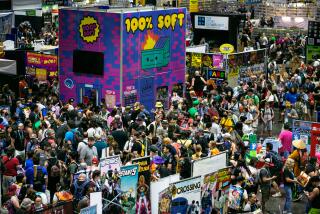Tricks of the Trade Shows
- Share via
IRVINE — Rock ‘n’ roll light shows. Waterfalls. Towers with 100 video monitors.
These are the tools of today’s trade show exhibit--high-tech gimmicks designed to grab the attention of crowds flocking to convention halls.
With the advent of large computer shows and more specialized medical and retail shows, more companies are booking space at trade shows and pouring out cash on flashy exhibits in hopes of setting themselves apart from competitors.
Nobody knows that better than Jim Stoneman, 47, president of Irvine-based Display Works, the largest trade show exhibit maker in Southern California. His business has swelled in recent years as companies have boosted their marketing budgets.
Display Works now designs and builds booths for such heavyweights as Toshiba, L’Oreal, Nike and Canon Computer Systems. “Our bigger customers spend a couple of million bucks a year [on exhibits],” Stoneman said.
Fueled by these corporate big spenders, the 165-person company has seen its sales triple to $14 million since 1994.
With a new office in San Francisco to tap the Silicon Valley and other lucrative businesses in the Bay Area, Stoneman expects sales to reach $19 million this year--impressive results in an industry filled with low-profile mom-and-pop shops.
“Most trade show companies are really cabinet shops; Display Works goes beyond that,” said Dan Hones, manager of Nike Retail Design, a design unit of the shoe giant. “They’ve got an incredibly detailed and talented design department.”
In Orange County, Display Works just moved its 130 local employees into a two-building, 205,000-square-foot facility deep in its high-tech clients’ territory, the Irvine Spectrum.
The large quarters allow Display Works to design and build large exhibits as well as store them year-round for clients. When the exhibits come back from a show, clients pay for repairs or modifications. Indeed, a cosmetic make-over for one of the large custom exhibits can run as much as $200,000.
The extra income is critical in an industry in which low profit margins--4% or less--are the rule. The income from these extra services can double that margin for Display Works, Stoneman said.
The company is also benefiting from a surge in trade shows. In the United States and Canada last year, there were 4,400 shows featuring at least 50 booths--25% more than in 1989, according to the Center for Exhibition Industry Research.
“If you look at the computer industry 10 years ago, there were probably 30 shows a year,” said Gene Halloran, Display Works general manager. “There are probably 100 times that many shows now.”
Despite the advances in telecommunications, companies continue to go to trade shows to spend time with potential customers and check out the competition. Some exhibitors, not content to sit and wait for visitors to drift by their booths, are arranging meetings and demonstrations with clients ahead of time, said Darlene Gudea of Trade Show Week.
It’s much different than when Stoneman, a pony-tailed surfer, started Display Works in the late 1970s. There were no rotating stages or digital displays then, just simple wooden backdrops, perhaps with a shelf to display products.
There weren’t many people in the business, either. “I remember when I first looked in the Yellow Pages, you could buy an exhibit from about eight people in Orange County,” Stoneman recalls. “You can probably buy one from 68 people here today.”
Stoneman was a graphic artist selling T-shirt designs and drawing corporate logos when he ventured into the exhibit business almost by chance. One of his clients, a meat company importing an elaborate ham slicer, asked him to put together a backdrop for a show.
“I said sure, not knowing anything about what a trade show or a backdrop was,” he recalls. He drew up a design for a 10-foot wooden exhibit and took it to a builder he picked out of the phone book.
“Because we didn’t know what we were doing it was different than anybody else’s,” Stoneman said. “That attracted some attention and we sold four just like that,” he said.
The assignment also had another benefit. Unlike his other work, Stoneman received half of his payment up front.
As the assignments came in, he added graphic artists, builders and a marketing staff, eventually bringing on Halloran as general manager to oversee day-to-day operations as the company grew over the years.
“I figured out I wasn’t the best guy to run the place,” Stoneman said.
Display Works has diversified its offerings to include modest portable displays for smaller companies and big three-dimensional retail displays for the chain of Nike Town retail stores. But large custom exhibits will remain the mainstay of the business because they are the big money makers, he said.
Computers have provided a big boost, according to Stoneman.
Once the company knows what a client wants, artists put together computerized renderings of a display. He believes corporate decisions are often based just on how cool the pictures look, not on practical concerns like price.
“The long and short of it is: If people like the pictures that these guys draw down here, they will pay whatever you are asking,” he said.
*
Display Works finds that the number of competitors has dwindled in recent years, but that the survivors are battling harder than ever for clients.
“The industry is definitely consolidating,” said Courtney Chamberlain of the Center for Exhibition Industry Research. “Companies are merging and buying up other companies to stay in business,” she said.
Display Works reaped the benefits of one of these consolidations last year, when it hired a large group of disgruntled employees from a competitor in San Francisco. That new Display Works office, which serves clients in the Silicon Valley and San Francisco’s financial district, has garnered so much business it should eclipse the Orange County operation in about four years, Stoneman added.
“They’re getting more calls for people who want to have stuff done than they can handle right now,” he said.
The company also is looking to expand into the Midwest, but no acquisition deals have been worked out yet.
However, Stoneman insisted that Display Works won’t be the county’s next hot growth company.
“We are so low-tech. We’re not going to explode and reach the $1-billion mark,” he said.
(BEGIN TEXT OF INFOBOX / INFOGRAPHIC)
More Business in Show Business
The key measurements of the trade show business--including number of shows, attendance, exhibitors and the space needed--are all projected to grow. All data in millions, except number of shows:
*--*
Square feet Shows Attendance Exhibitors required 1996 4,400 101 1.25 448 1997 4,492 109 1.26 471 1998 4,587 118 1.27 496 1999 4,683 129 1.28 522 2000 4,781 140 1.30 550 Growth 9% 39% 4% 23%
*--*
****
The medical/health-care industry easily topped the list of shows held in 1996:
1. Medical/health care: 468
2. Home furnishings/interior design: 277
3. Computers/computer applications: 275
4. Education: 263
5. Sporting goods/recreation: 253
6. Building/construction: 233
7. Agriculture/farming: 177
8. Apparel: 153
9. Industrial: 150
10. Boats: 149
****
Trade vs. Consumer Shows
Consumer shows open to the public are more widely attended than trade exhibits, which restrict attendance to industry representatives. Trade shows, though, attract more companies. Averages for 1996 shows:
*--*
Trade shows Consumer shows Attendance 10,385 47,522 Exhibiting companies 400 238 Exhibit space* 119,849 103,841 Booth size* 300 168
*--*
* Square feet
Sources: 1996 Tradeshow Week Data Book, Center for Exhibition Industry Research
More to Read
Inside the business of entertainment
The Wide Shot brings you news, analysis and insights on everything from streaming wars to production — and what it all means for the future.
You may occasionally receive promotional content from the Los Angeles Times.










